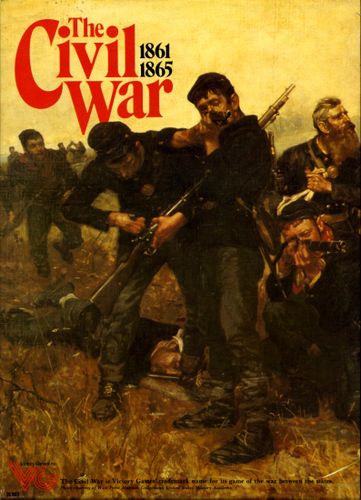|
Advertisement
|
The Civil War 1861-1865

DescriptionThis sprawling rendition of the American Civil War tries to fit in everything, from Grant and Lee down to Indian raids in the Western territories. It also includes the most extensive treatment of naval and riverine warfare of any strategic Civil War game. The map covers the theater of the war from the Eastern seaboard to the middle of Texas at 25 miles per hex. An optional second map extends to New Mexico. There are five turns per year, four of two months each and a four-month Winter turn. Each turn consists of an indefinite number of "pulses" and may last a long, long time. Troops are represented by generic Strength Points (about 5,000 men per SP, or one or two ironclads with escorting naval vessels). The key concepts in the game are Theaters, Command Points, Pulses and Leaders.
The game has much more: an elaborate combat resolution procedure, somewhat less elaborate supply rules, a naval system that is a game in itself, cavalry, railroads, militia, neutral states and a chrome-laden option to add the Far West map and Theater. Players gain Victory Points primarily by capturing major enemy and neutral cities and winning neutral states to their side. The South also gets VP's for successful commerce raiding and for isolating or capturing Washington, D.C. It wins at once if it captures Washington at a moment when it has more VP's than the North. Otherwise, VP's are checked in November 1864 and April 1865, when the game comes to a definitive end. For those who lack time or patience for the full war, scenarios are provided with the historical setups as of the start of 1862, 1863 and 1864. The Civil War isn't the biggest game ever produced on that dreadful conflict, but it is certainly among the most ambitious in its scope and degree of detail. Includes 520 counters. Game DiscussionsAdd CommentYou need to be logged in to comment. Insert Bullet List Please enter at least one item. Item: Item: Item: Item: Item: Insert Numeric List Please enter at least one item. Item: Item: Item: Item: Item: Insert Link Please enter the link of the website Optionally you can add display text Insert Email Please enter the email address Optionally add any display text Insert Image Please enter the link of the image Insert YouTube Video Please enter the link of the video Marketplace | ||||

Comments (0)